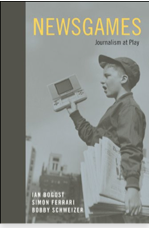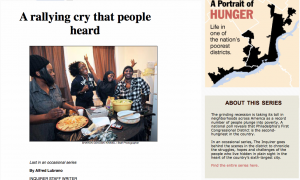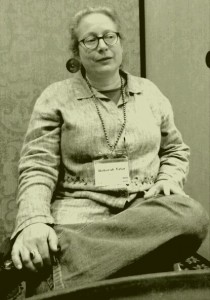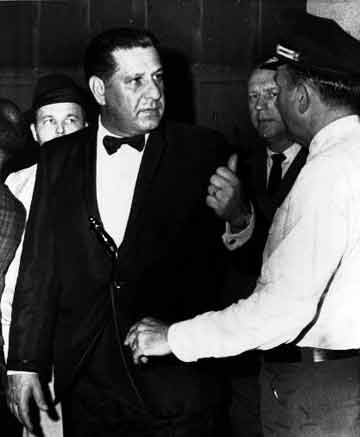This fall, I am teaching a class, “Serious Games for News, ” in which journalism and interactive multimedia students will analyze and design various examples of “newsgames.” In their book, Newsgames: Journalism at Play(MIT Press, 2010) Ian Bogost and his colleagues use the term Newsgames to mean, broadly, using game design techniques to “do” journalism – that is to report, present and or comment on the news. That broad definition takes in everything from crossword puzzles to videogame-like simulations and alternate reality games of the type created by futurist Jane McGonigal. Since the students in the class are journalism and interactive multimedia majors, not computer science students, I see the class as a practical exploration of computer science concepts relevant to journalism, as well as an opportunity to learn about and test the possibilities of this rapidly developing journalistic medium.

The journalistic focus of the class will be on two pressing issues in Trenton New Jersey, the city just blocks away from the location of our college -pollution and food security. Trenton has experienced the difficulties that have beset many industrial American cities: disinvestment, environmental degradation, and a crumbling infrastructure. Enrollments in the federal supplemental nutrition assistance program have risen precipitously in the last five years. How can newsgames make the issues more visible, more comprehensible, and more amenable to citizen dialogue, engagement and resolution?
As part of my preparation for the class, I thought I would create a sample newsgame in Scratch for the students to critique and remix. The the game below challenges players to buy a week’s worth of groceries on a food stamp budget – about $30/week, according to my research. (The title reflects my age – when I was growing up, people getting government assistance to buy food got a coupon book from what was called the Food Stamp program. Now, they get an ATM-like card called an “EBT card,” and the program is now called the Supplemental Nutrition Assistance Program.)
The version below is in the user testing phase and will probably undergo some refinements in the fall, but I do not intend to present it to students as a finished product. In addition to some technical glitches, I think it has some important design flaws. I don’t think it has enough story elements to make recreate the experience of having to shop with an EBT card. (what . I have some ideas on how to make it more realistic – swap out the images for images from Trenton, add voices and back stories of real people, add more items to better illustrate the trade-offs people have to make..
Part of the conversation that I want to have with the students is to raise the question of how much information needs to be built into the game, and how much would need to be part of another story package. Maybe this is the wrong focus for a game about food insecurity in Trenton – perhaps the focus should be on applying for benefits, or running one of our over-stretched food pantries. Perhaps it can be part of a suite of games around this theme.
The idea is to get the students to first try to improve on what I’ve done, and use the strength and weaknesses of my approach, along with the guidance from the texts, to develop their own ideas.
In this series of posts, I want to share some thoughts about what I expect my students to learn from working with this game and creating others like it.
A Note on the Use of Scratch
I chose to use the Scratch programming language for this class for the following reasons:
- It has a low learning curve, but contains many of the features of more sophisticated languages
- It allows programmers to import their own still images and audio, which means that we ought to be able to achieve a strong documentary effect on the games we produce.
- The Scratch website makes it easy to organize student work into galleries, and the uploading feature of the software has built-in version control, so it’s easy to see how projects evolve.
- Interactive games and stories can be prototyped in Scratch relatively quickly for larger scale production in a subsequent course. We have done this successfully for several years at The College of New Jersey.
In reflecting upon the game design process in the context of journalism pedagogy, and on the use I expect to make of this game in particular, a series of guiding questions and considerations emerge that I want to share here.
Game design as journalism: general questions and considerations
- What’s the journalistic goal of making this or any other newsgame?As with text, video, audio, still images and static information graphics, the value of news games as journalism is a function of editorial judgment and skill. Regardless of the medium, the focus is on the story one is trying to tell.
My goal with the food stamp game is to find new ways to share information and provoke conversations about poverty and the problem of healthy food access in poor communities. The actual experience of shopping with an electronic benefits card (EBT card for short) is something that many Americans, and thousands of Trenton-area residents experienced for the first time during the economic downturn of the last few years. They have joined an often-invisible army of millions. In 2008, the Columbia Journalism Review considered the need for fresh ways of shining a spotlight on the problems of the poor:
“How can a reporter cover that most persistent of problems, poverty, today without making it boring and predictable, or guilt-tripping readers and turning them off?”
Hypothetically, simulations of how poor people attempt to meet basic needs might be a way of engaging news consumers and encouraging further exploration of the issues raised. To test this hypothesis, I plan to have students consider how the Food Stamp game might be improved both as a work of journalism and as a computing artifact. As the course evolves, I expect that other approaches to these and similar projects to emerge.
- What kinds of stories and issues lend themselves best to newsgames and especially, to which type of game? Should the game stand alone or should it be combined with other forms of storytelling and exposition?
Using Wired.com’s “Cutthroat Capitalism” interactive feature and simulation game about the business model behind Somali piracy as an example, the Bogost text notes that game design techniques open up ways of revealing complex systems. Both the feature and the game make the point that piracy continues off the coast of Somalia because the shipping companies targeted find it more profitable to risk being pirated and pay ransoms than to change their shipping routes. For their parts, the pirates also find the potential wealth to be garnered from crime to be more lucrative than the alternatives available to them, despite the risk of arrest or violence.
The feature uses the expository technique of process analysis, a method for explaining the how or why something happens or is done. This is a common technique in magazine writing, especially for articles designed to impart personal advice, or to explain how a big news event happened. tt frequently lends itself to a very structured layout with accompanying graphics. (This Jan. 1992 Black Enterprise package, “The Big Comeback” which I worked on with Dawn Baskerville, is typical – it offers advice on how to recover after falling into debt.)
The Wired.com narrative feature, though, tries to do something more ambitious, which is to make an economic analysis interesting and accessible.

It is organized into four sections:
- The Hot Zone:Pirates Know Plunder Pays
- The Attack: Shippers Brave Shortcuts Through Pirate Waters
- The Negotiation: Offer or Counteroffer, Shoot or Stand Down?
- The Resolution: Sealing the Deal and the Getaway
From the perspectives of computer science and game design, Wired.com structured and highly visual approach to the narrative was highly conducive to the kind of abstraction needed to create a game to complement the feature.
The process analysis method contrasts with the human-interest angle, another popular feature writing technique for approaching complex issues. Human interest stories help us understand what it feels like to be caught in the middle of a complex event, as Alfred Lubrano of the Philadelphia Inquirer does beautifully in his 2010 series on hunger in Philadelphia’s first congressional district. Lubrano shows us hardworking parents rendered incapable of feeding their kids by sudden job losses, and spotlights a dedicated social worker struggling to help them. The series had an impact, too – readers responded by helping one mother find a new job and an apartment.
In theory, a well-designed game could complement a strong human-interest series. The food stamp game is one example of such a complementary

effort. Other examples might be designed around the challenges faced by a social worker struggling with a burgeoning caseload, or a social entrepreneur looking for ways to bring jobs and a healthy environment back to the community.
- How do the journalism goals of the game translate into design requirements – and constraints- for the game?
Creating a game from a complex narrative, whether real or imagined, requires a level of abstraction that can have all kinds of unintended results. The interactive story Façade has been hailed for the sophistication of the artificial intelligence that allows the gamer to participate in a drama whose narrative arc bears an impressive similarity to the Edward Albee masterpiece, Whose Afraid of Virginia Woolf. In 2007 and 2008, I asked a number of students and others to play Façade and observed the results. After watching about 40 people between the ages of 15 and 45 participate in the story, I saw a consistent tendency to “game” the story. Instead of becoming immersed in the drama, players did things that they thought would skew the game one way or another, often with results they found hilarious. I think that this was partially a function of the rudimentary quality of the 3-D graphics (a compromised necessitated by the processing requirements of the AI.) It became obvious that the experience of Façade is nothing like that of the drama that inspired it. This may be fine in this instance because the two works stand apart from each other, but a similar result in a game with a journalistic purpose threatens to trivialize the story or issue that it is trying to elucidate.
Clearly, then, the journalistic success of The Food Stamp Game project requires careful attention to the dramatic elements – or the storytelling experience of the game, along with the formal game elements (such as rules) or the technical requirements. For a further understanding of these challenges, I will have students turn to the guidance in Tracy Fullerton’s Game Design Workshop: A Playcentric Approach to Creating Innovative Games along with some of the project management techniques that my colleagues and I have developed in seven years of teaching game design at The College of New Jersey. I will discuss this in a subsequent post.
Acknowledgements: This work draws upon research funded by Microsoft Research and National Science Foundation grants 0739173 and 0829616



